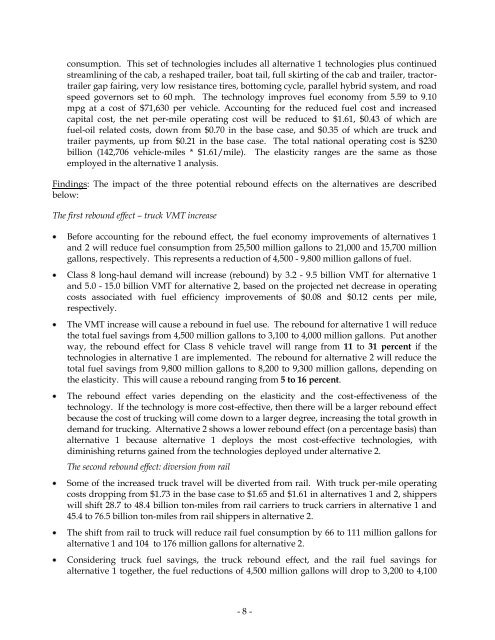Assessment of Fuel Economy Technologies for Medium and Heavy ...
Assessment of Fuel Economy Technologies for Medium and Heavy ...
Assessment of Fuel Economy Technologies for Medium and Heavy ...
You also want an ePaper? Increase the reach of your titles
YUMPU automatically turns print PDFs into web optimized ePapers that Google loves.
consumption. This set <strong>of</strong> technologies includes all alternative 1 technologies plus continued<br />
streamlining <strong>of</strong> the cab, a reshaped trailer, boat tail, full skirting <strong>of</strong> the cab <strong>and</strong> trailer, tractortrailer<br />
gap fairing, very low resistance tires, bottoming cycle, parallel hybrid system, <strong>and</strong> road<br />
speed governors set to 60 mph. The technology improves fuel economy from 5.59 to 9.10<br />
mpg at a cost <strong>of</strong> $71,630 per vehicle. Accounting <strong>for</strong> the reduced fuel cost <strong>and</strong> increased<br />
capital cost, the net per-mile operating cost will be reduced to $1.61, $0.43 <strong>of</strong> which are<br />
fuel-oil related costs, down from $0.70 in the base case, <strong>and</strong> $0.35 <strong>of</strong> which are truck <strong>and</strong><br />
trailer payments, up from $0.21 in the base case. The total national operating cost is $230<br />
billion (142,706 vehicle-miles * $1.61/mile). The elasticity ranges are the same as those<br />
employed in the alternative 1 analysis.<br />
Findings: The impact <strong>of</strong> the three potential rebound effects on the alternatives are described<br />
below:<br />
The first rebound effect – truck VMT increase<br />
Be<strong>for</strong>e accounting <strong>for</strong> the rebound effect, the fuel economy improvements <strong>of</strong> alternatives 1<br />
<strong>and</strong> 2 will reduce fuel consumption from 25,500 million gallons to 21,000 <strong>and</strong> 15,700 million<br />
gallons, respectively. This represents a reduction <strong>of</strong> 4,500 - 9,800 million gallons <strong>of</strong> fuel.<br />
Class 8 long-haul dem<strong>and</strong> will increase (rebound) by 3.2 - 9.5 billion VMT <strong>for</strong> alternative 1<br />
<strong>and</strong> 5.0 - 15.0 billion VMT <strong>for</strong> alternative 2, based on the projected net decrease in operating<br />
costs associated with fuel efficiency improvements <strong>of</strong> $0.08 <strong>and</strong> $0.12 cents per mile,<br />
respectively.<br />
The VMT increase will cause a rebound in fuel use. The rebound <strong>for</strong> alternative 1 will reduce<br />
the total fuel savings from 4,500 million gallons to 3,100 to 4,000 million gallons. Put another<br />
way, the rebound effect <strong>for</strong> Class 8 vehicle travel will range from 11 to 31 percent if the<br />
technologies in alternative 1 are implemented. The rebound <strong>for</strong> alternative 2 will reduce the<br />
total fuel savings from 9,800 million gallons to 8,200 to 9,300 million gallons, depending on<br />
the elasticity. This will cause a rebound ranging from 5 to 16 percent.<br />
The rebound effect varies depending on the elasticity <strong>and</strong> the cost-effectiveness <strong>of</strong> the<br />
technology. If the technology is more cost-effective, then there will be a larger rebound effect<br />
because the cost <strong>of</strong> trucking will come down to a larger degree, increasing the total growth in<br />
dem<strong>and</strong> <strong>for</strong> trucking. Alternative 2 shows a lower rebound effect (on a percentage basis) than<br />
alternative 1 because alternative 1 deploys the most cost-effective technologies, with<br />
diminishing returns gained from the technologies deployed under alternative 2.<br />
The second rebound effect: diversion from rail<br />
Some <strong>of</strong> the increased truck travel will be diverted from rail. With truck per-mile operating<br />
costs dropping from $1.73 in the base case to $1.65 <strong>and</strong> $1.61 in alternatives 1 <strong>and</strong> 2, shippers<br />
will shift 28.7 to 48.4 billion ton-miles from rail carriers to truck carriers in alternative 1 <strong>and</strong><br />
45.4 to 76.5 billion ton-miles from rail shippers in alternative 2.<br />
The shift from rail to truck will reduce rail fuel consumption by 66 to 111 million gallons <strong>for</strong><br />
alternative 1 <strong>and</strong> 104 to 176 million gallons <strong>for</strong> alternative 2.<br />
Considering truck fuel savings, the truck rebound effect, <strong>and</strong> the rail fuel savings <strong>for</strong><br />
alternative 1 together, the fuel reductions <strong>of</strong> 4,500 million gallons will drop to 3,200 to 4,100<br />
- 8 -
















